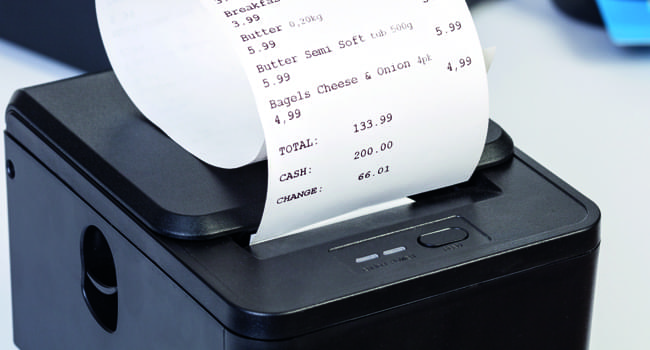Increasing use of personalization and evolving technology are driving growth in thermal printing, according to a new report from Smithers,
The Future of Thermal Printing to 2025. Society is continually evolving into a more technologically competent state. Today, this involves daily shopping on Amazon, Deliveroo or Waitrose delivery. This shift by society feeds the need for thermally printed products such as labels and tags, creating global demand for thermal print equipment and consumables that will reach $34.11 billion in 2020.
Because of COVID-19 a 6.2% drop in demand will take place in 2020 when compared to 2019 as the industry and supply chains adjust to unprecedented conditions. An immediate recovery is unlikely, but the potential for effective vaccination programmes are creating more market optimism for 2021. Although thermal print revenues are not expected to regain their 2019 level until 2022. Smithers estimates the global market size at the end-user will rise to $42.31 billion by 2025, representing a 4.4% CAGR over the forecast period. Printer sales market share is approximately 28% of all thermal sales in 2020 and is predicted to grow at 4.7% CAGR – marginally faster than printing supplies, which stand at 4.3% CAGR.
Thriving end-user markets
With wide spread application in retail, manufacturing and transportation, the thermal printer is ideal for personalising and for creating unique information. It can be encoded or human readable. We see examples of this in barcoded labels, identity cards, customer engagement messages on receipts, boarding passes, gaming tickets and so on. The printer satisfies the ‘print right here’ trend seen in many applications, including kiosks, receipts, manufacturing processes, instant photo prints and mobile workforce printing, and contributes to the overall operation efficiency.
Within the key end-user markets, retail will retain the biggest share at 32.2% of total revenues in 2020 with $10.89 billion, and will see recovery back to 2019 levels within 2021 and continue to grow by 3.5% CAGR over the report period to reach $13.04 billion in 2025 with a slight share loss down to 30.8% as other markets recover at faster rates. The second-largest segment is manufacturing, which will see a share gain from 20.8% in 2020 to 26.2% by 2025 and will return back to 2019 levels by 2022; growth rate is forecasted to be 4.7% CAGR with 2020 values of $7.11 billion and will grow to $8.95 billion by 2025.
Regional market development
The Asia-Pacific region, valued at $13.21 billion in 2020, will see a continuation of its accelerating growth with recovery already in place in 2020 and reach $17.75 billion by 2025 – with China being the power house and following its ‘Made in China 2025’ strategic plan. The second-largest region, North America, is valued at $8.31 billion in 2020 and will see the slowest return, which is not forecasted to reach 2019 levels until the latter stages of 2025 when it will finish with an estimated $9.17 billion. Growth rates for each of these regions are 6.1% CAGR for Asia-Pacific and 2.0% for the North America region. The third-largest area, Western Europe at $7.23 billion in 2020, will grow more rapidly than North America with a CAGR of 3.8% and will recover in 2022 and reach $8.71 billion by 2025.
POS receipt systems in North America, Japan and Western Europe are saturated due to the high sophistication of their retail industries. In North America receipt paper volumes are slowly declining while values remain adequate. This is due to the increased move to app-style receipt systems and email. Western Europe receipts are still the consumers’ preference due to high cash sales and fiscal audit requirements. Eastern European and Asia-Pacific markets are semi-penetrated as organised retail systems replace older chaotic systems.
These markets will saturate quickly due to the pressures being applied to control taxation, particularly in China and Russia. Russia is still (2019) seen as an opportunity for sales growth due to the slow uptake of POS systems, with many regions still using more old-fashioned POS ticketing. India is rapidly changing from small business models to superstore growth. South & Central America has not reached saturation for POS systems, except for Mexico.
Customer engagement and labeling initiatives
Increased customer engagement and initiatives are also fueling growth, for example receipts from large retailers – such as Target, Walmart, Kohl’s, Tesco and Marks & Spencer – have increased in size by as much as 30% as retailers add customer engagement items like coupons, messaging, loyalty points, in-store savings, directions for online survey information and sweepstake entries. The goal is to add consumers to the online database for future engagement and advertising.
There are several government-led initiatives in North America and Europe that are driving additional product labelling in the US and international markets. In the US the initiative is called the DSCSA, and within the European Union it is called the FMD. These initiatives require the use of obligatory safety features – a unique identifier and an antitampering device – on the outer packaging of medicines, and these are best done through thermally printed adhesive labels, which can consist of tamper-evident fragmenting labels or simpler labels with a perforation showing they’ve been opened.
